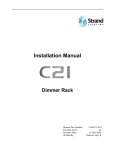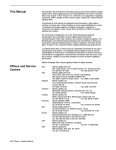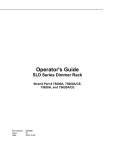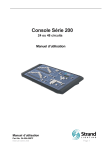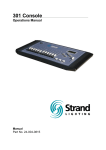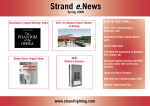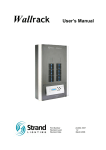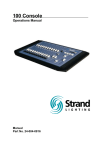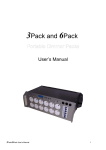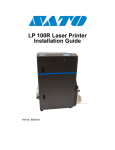Download Installation Manual
Transcript
. Installation Manual SLD96 Dimmer Rack Strand Part # 75600A and 75600A/CE Part Number: Revision: Date: 40/B981 A 18-Jun-2002 The material in this manual is for information purposes only and is subject to change without notice. Strand Lighting assumes no responsibility for any errors or omissions, which may appear in this manual. For comments and suggestions regarding corrections and/or updates to this manual, please contact the nearest Strand Lighting office. El contenido de este manual es solamente para información y está sujeto a cambios sin previo aviso. Strand Lighting no asume responsabilidad por errores o omisiones que puedan aparecer. Cualquier comentario, sugerencia o corrección con respecto a este manual, favor de dirijirlo a la oficina de Strand Lighting más cercana. Der Inhalt dieses Handbuches ist nur für Informationszwecke gedacht, Aenderungen sind vorbehalten. Strand Lighting uebernimmt keine Verantwortung für Fehler oder Irrtuemer, die in diesem Handbuch auftreten. Für Bemerkungen und Verbesserungsvorschlaege oder Vorschlaege in Bezug auf Korrekturen und/oder Aktualisierungen in diesem Handbuch, moechten wir Sie bitten, Kontakt mit der naechsten Strand Lighting-Niederlassung aufzunehmen. Le matériel décrit dans ce manuel est pour information seulement et est sujet à changements sans préavis. La compagnie Strand Lighting n’assume aucune responsibilité sur toute erreur ou ommission inscrite dans ce manuel. Pour tous commentaires ou suggestions concernant des corrections et/ou les mises à jour de ce manuel, veuillez s’ll vous plait contacter le bureau de Strand Lighting le plus proche. Copyright 2001-2002, Strand Lighting. All rights reserved. Information contained in this document may not be duplicated in full or in part by any person without prior written approval of Strand Lighting Ltd. Its sole purpose is to provide the user with detailed installation information for the equipment supplied. The use of this document for all other purposes is specifically prohibited Prefix Thank you for choosing Strand Lighting SLD96 dimmer racks. We trust that the equipment will meet all your dimming needs and will provide you with reliable service for many years. Strand Lighting can assure you that every effort has been made to ensure that the equipment has been designed to meet the highest professional standards and that dimmer racks and their components have been assembled, inspected, and tested in accordance with our strict quality assurance program. SLD96 dimmer racks also comply with the requirements of UL, cUL, CE, and TUV. Should you encounter any problems or difficulties with your dimmer racks, please contact the nearest Strand Lighting service representative. For a complete list of Strand Lighting offices and service centers, see the back of this manual or our Web site (www.strandlighting.com). This manual describes the installation procedures for SLD96 dimmer racks. A separate Operator's Guide provided with the dimmer racks describes the hardware and software comprising the dimmer rack, and its use. Page i SLD96 Dimmer Rack Definition of Terms This manual uses the following terms throughout: circuit dimmer A device controlling power to a lighting fixture. Two lights on the same dimmer cannot be separately controlled. DMX A protocol used to transmit data (usually dimmer information) from a lighting controller to a dimmer rack using a single cable to control all dimmers rather than a pair of wires for each dimmer. phase The three phases of the mains supply to which the dimmers are connected. These are usually identified as phase 1, phase 2, and phase 3 in Europe and as phase A, phase B, and phase C in the United States. rack number A number used to uniquely identify each dimmer rack in a multiple rack system. Rack numbers are set from the front panel of the rack processor module, and are usually set by the installation engineer. SSR (Solid State relay) A power control device used in Strand dimmers that contains two silicon control rectifiers (SCRs), control circuitry, and optical isolation circuitry. SWC (System Wide Control) A method of programming and controlling more than one dimmer rack simultaneously. A hand held controller lets you program and recall 99 presets, and control individual dimmers. Reporter Outlook Micro-control Installation Manual Connection device and wiring for powering a lighting fixture from a dimmer. There are two reporting products that can operate with SLD96 dimmer racks. Reporter PC is a program that runs under Microsoft Windows and lets you set up certain Strand Lighting dimmer racks and cabinets (including SLD96 racks). The Reporter software for Strand 300 and 500 series lighting control consoles lets you record and display the status of all lights and record rack-based backup cues. A digital architectural control system for use with SLD96 dimmer racks. An analog architectural control system for use with SLD96 dimmer racks. Page ii Contents This manual describes the installation of the SLD96 dimmer rack. The installer should refer to the separate SLD96 Operator's Guide for a general description and specification of the dimmer rack and for detailed information concerning the initial setup procedures referred to in the Commissioning section of this manual. Basic Troubleshooting is also provided in the SLD96 Operator's Guide. Section 1 - Hardware Description................................................. 3 General ..............................................................................................................3 Construction .......................................................................................................4 Section 2 - Installation................................................................... 8 Environmental Considerations ...........................................................................8 Conduit Layout ...................................................................................................9 Positioning the Dimmer Rack(s) .......................................................................10 Preparing the Rack for Wiring ..........................................................................11 Locating Dimmer Components.........................................................................14 Power Wiring....................................................................................................16 Load Wiring ......................................................................................................19 Connecting the Dimmer Control Ribbon Cables...............................................21 Connecting the Fan Cable................................................................................21 Connecting the Control Signal wiring ...............................................................22 Configuring Dimmer Slots ................................................................................29 Identifying Dimmer Slots ..................................................................................29 Final Assembly.................................................................................................29 Changing the Door Direction ............................................................................30 Section 3 - Commissioning......................................................... 31 Safety Check....................................................................................................31 Initial Power Up ................................................................................................31 Processor Self Test and Fault Identification .....................................................31 Output Check ...................................................................................................32 Initial Programming ..........................................................................................32 Programming and Fault-Finding .......................................................................33 Appendix A - Back Plane Board DIP Switches.......................... 34 Index.............................................................................................. 36 Offices and Service Centers ....................................................... 39 Tables Table 1 - DMX512 Control Wiring ...........................................................23 Table 2 - SWC and Outlook Wall Station Termination.............................24 Table 3 - 6-pin Wall Jack Termination ......................................................24 Table 4 - Wiring and Termination .............................................................25 Table 5 - Rack Interconnection Cable Colors............................................28 Page 1 SLD96 Dimmer Rack Figures Figure 1 - SLD96 Rack Layout Fully Populated (doors removed)..............3 Figure 2 - Processor Assembly ....................................................................5 Figure 3 - Rack Processor Module ..............................................................6 Figure 4 - Power Supply Module.................................................................6 Figure 5 - Ethernet Module..........................................................................7 Figure 6 - Dual Dimmer Module .................................................................7 Figure 7 - Recommended Conduit Cutouts .................................................9 Figure 8 - Mounting dimensions................................................................10 Figure 9 - Clearances .................................................................................11 Figure 10 - Removing the Processor Assembly.........................................12 Figure 11 - Removing Module Chimneys .................................................12 Figure 12 - Removing the Fan Box ...........................................................13 Figure 13 - Removing Amp Traps.............................................................13 Figure 14 - SLD96 Dimmer Rack..............................................................14 Figure 15 - SLD96 Dimmer Rack Side View............................................15 Figure 16 - Bus Bar Connections Behind Processor Assembly.................16 Figure 17 - Bus Bar Connection Detail .....................................................16 Figure 18 - Inter-Rack Bussing..................................................................17 Figure 19 - Earth Ground Connector Plate ................................................17 Figure 20 - Amp Trap Installation Torque.................................................18 Figure 21 - Routing the Load Wiring ........................................................19 Figure 22 - SLD96 Dual Dimmer Module Load Connections...................20 Figure 23 - Load Finger for Single Dimmer Modules ...............................20 Figure 24 - Connecting Power to the Processor Assembly........................20 Figure 25 - Dimmer Control Ribbon Cables..............................................21 Figure 26 - Connecting the Ribbon Cables and Fan Cable........................21 Figure 27 - Interconnection Card...............................................................22 Figure 28 - DMX512 Control Wiring........................................................23 Figure 29 - SWC/Outlook Control Wiring ................................................24 Figure 30 - Reporter PC Control Wiring ...................................................25 Figure 31 - Panic Control Wiring ..............................................................26 Figure 32 - Automatic Panic Setting..........................................................26 Figure 33 - Analog Control Wiring ...........................................................27 Figure 34 - RJ45 Connections On the Processor Assembly ......................27 Figure 35 - RJ45 Connectors .....................................................................28 Figure 36 - Line terminator Links..............................................................28 Figure 37 - Dimmer Terminal Molding with Break-off Lugs ...................29 Figure 38 - SLD96 Rack Showing Hinge Plate and Doors .......................30 Figure 39 - Rack Processor Module Front Panel .......................................31 Figure 40 - Back plane Board DIP Switch Settings...................................34 Figure 41 - Back plane Board DIP Switch Locations................................35 Installation Manual Page 2 Section 1 - Hardware Description General The SLD96 dimmer rack is a UL, cUL, CE, and TUV listed, free standing, factory assembly of galvanized steel construction finished in thermally set, scratchresistant powder coat paint. Each rack houses up to 48 single or dual dimmer modules and a processor assembly containing either one or two rack processor modules, a power supply module, and an optional Ethernet module. Forced-air cooling is provided by fan housings at the top and bottom of the rack, each of which contains two variablespeed 24VDC fans. Air is forced from each fan module through three module chimneys and into the back of the dimmer modules. Dimmer connectors in the rack are keyed so that higher amperage dimmer modules cannot be plugged into lower amperage slots. Fan Housing Single or Dual Dimmer Modules Ethernet Module (optional) Power Supply Module Backup Rack Processor Module (optional) Rack Processor Module Fan Housing Figure 1 - SLD96 Rack Layout Fully Populated (doors removed) Page 3 SLD96 Dimmer Rack Construction The dimmer rack is of galvanized construction with bolt-on covers. The rack contains six removable chimneys for the dimmer modules. The rack, chimneys, and all modules are earth grounded. Two hinged, locking doors cover the front of the dimmer modules, leaving access to the operator controls on the rack processor module. Rack components are designed for easy removal and installation so that the dimmer rack is open and empty during installation. Mounting holes are provided so that racks can be bolted together and to the floor or wall. Size and Weight Dimensions: Weight: Width 600mm (23.62 in), Height 2050mm (80.70 in), Depth 575mm (22.64 in) With 48 dual standard dimmers, power supply module, and one rack processor module - 358kg (790 lbs) Without dimmer modules, rack processor modules, and power supply module - 223 kg (492 lbs) Contracting Access Power cable entry, supplying power to the bus bars is either through the top of the rack, or through the bottom. Contractor load wire connections for the live and neutral are through the top, or bottom of the rack and directly onto the module connector. Supply Connection The rack is provided with three phase plus neutral and earth bus bar distribution, located in the center of the rack. The maximum power rating for this system is 800A per phase (600A per phase in Europe). Bussing across multiple racks is possible using the rack interconnection bussing kit (see table on page 17). Note: The standard SLD96 rack (part number 75600A in the U.S.A. and 75600A/CE in Europe) is supplied to support 3-phase star (wye) power. Racks for 3-phase delta power are available under a separate part number (75610A in the U.S.A. and 75610A/CE in Europe). The contracting chamber is sized to meet UL, cUL CE, and TUV wiring space constraints. Supply Voltage The SLD96 rack is suitable for use with supply voltages of between 90 and 264VAC power. Supply Frequency The SLD96 rack is suitable for a supply frequency range of 47 to 63 Hz. Phasing Phasing within the rack is sequential across the dimmer slots, running in the phase sequence A, B, C. All dimmers in a vertical stack down the rack are on the same phase. In dual dimmer modules, both dimmers are on the same phase. The dimmer rack software refers to phase A as L1, phase B as L2, and Phase C as L3. When looking on the front of the dimmer rack, phase L1 is on the left-hand side, phase L2 is in the middle, and phase L3 is on the right-hand side. Dimmer Module The dimmer modules connect to the rack via standard female connectors within a Connectors plastic molding. Male connectors on the rack consist of copper fingers in a plastic molding. The connector is self-aligning when the module is inserted. An earth ground connection to a common ground strap is provided. Signal connection to the modules is via a 16-way ribbon connection per phase from the processor assembly to a series of back plane printed circuit boards. Load wiring is made directly to terminals at the side of the individual module connector pins. The aperture for load wiring is suitable for wire gauge #6AWG through #12AWG (10mm2 through 2.5mm2) Installation Manual Page 4 Control Input/Output The termination card contains all terminals for control input/output, and RJ45 ports Connection for interconnecting DMX, SWC/Outlook, and Reporter PC between racks. A local RS232 port on the front of the rack processor module(s) lets you connect a Reporter PC for diagnostic and setup work on individual racks. Cooling Fans Four low-noise variable-speed fans provide cooling for the dimmer rack. Cooling air is pushed up or down through an air plenum and exhausted through venting in the front of the individual dimmer modules. The fans can be set to fixed or variable speeds. The fixed speed fan setting is for situations where changes in fan noise are a problem. With this setting, the fans are always full on when the dimmers rack is on. The variable speed fan setting minimizes noise and maximizes fan life. With this setting the fan speed varies based on load current. Processor Assembly Each SLD96 dimmer rack contains a processor assembly. This assembly houses the rack processor module(s), power supply module, and optional Ethernet module. The termination card for the rack is mounted on the rear of the processor assembly. The processor assembly can be equipped with one or two rack processor modules. The optional second processor module acts as a redundant full tracking backup and is automatically activated if the main processor fails. The configuration data from either processor is automatically transferred into the other processor. The currently inactive processor always tracks the currently active processor. Front Rack Processor Module(s) Ethernet Module Power Supply Unit Rear Temination Card Figure 2 - Processor Assembly Page 5 SLD96 Dimmer Rack Note: When only one rack processor module is supplied it is placed in the bottom slot, with a blank plate fitted in the top slot. If an Ethernet module is supplied it is placed in the slot above the power supply module. Rack Processor Module Each SLD96 dimmer rack contains either one or two plug-in, fully digital rack processor modules. When present, the second rack processor module acts as a redundant full tracking backup to the main rack processor module. Each rack processor module has a 16 character by 2 line backlit LCD display used, together with a 6 key keypad, to access the system menus. Nine LEDs display the rack processor module and dimmer status. All programmed data is held in battery maintained RAM in the rack processor module for up to 6 months without power to the rack. An RS232 signal connector is provided on the front of the rack processor module for local connection to a PC, providing setup, playback, library storage, and reporter supervision. LCD Menu Keys LEDs Rs232 Connector Figure 3 - Rack Processor Module Power Supply Module The power supply module supplies power to the cooling fans, rack processor module(s) and all low voltage electronic controls within the SLD96 dimmer rack. It can also supply power to external Micro-control and SWC/Outlook wall stations. Figure 4 - Power Supply Module Installation Manual Page 6 Ethernet Module The optional Ethernet module lets the rack be included in a Strand ShowNet network or other compatible Ethernet network. Figure 5 - Ethernet Module Termination Card The following external connections are made at the Termination Card. • Two optically isolated DMX512 control inputs. Each DMX input has a patch to allow overlapping or separation of any DMX control level. • 12 analog 0 to 10V signal inputs, fully patchable to any rack dimmer circuit. • Input for System Wide Control (SWC) and Outlook wall stations. • Plug in facility for connection of external panic set and reset buttons. • RJ45 connectors for inter-rack connection of DMX, SWC and Reporter signals. The termination card also connects the 3-phase power from the rack to the power supply module and provides the supply and control wiring to the two cooling fans. Dimmer Modules The dimmer modules are the high power switching section of the SLD96 dimming system and are the interface between high power AC and low power control. It is driven by low-level signals and switches high-level electrical power. Load status reporting electronics is standard on all dimmer modules. All types of dimmers can be mixed in any combination in a rack. This lets you use the exact dimmer type and rating needed for each circuit (see Configuring Dimmer Slots on page 29). Each reporting dimmer module contains a temperature sensor that will report its temperature to the rack and the Reporter PC, and force the fans to full speed if necessary (when set to Variable control). Circuit Breaker 1 Rating Label Dimmer LEDs Circuit Breaker 2 Figure 6 - Dual Dimmer Module Page 7 SLD96 Dimmer Rack Section 2 - Installation Environmental Considerations Before installing your SLD96 rack, you should carefully consider the environment in which the equipment is to be installed, the power feeding the equipment and the required conduit and/or cable runs. To maximize equipment life and minimize the chance of failures, the following environmental requirements should be met: • • • • Warning Operating temperature: 0 to 35°C ambient Operating Humidity: 10%-95% non-condensing Storage temperature: -40°C to 70°C Storage Humidity- 0% to 95% non-condensing Dimmer rack efficiency is at least 97%. Since the remainder of the energy is dissipated as heat, racks should be installed in a room with adequate ventilation to dissipate a heat load equivalent to at least 3% of the maximum load the dimmer racks will handle. Electrical equipment must not be used in close proximity to flammable materials. This equipment is for indoor use only Do not obstruct the ventilation at the front of the dimmer rack A 90 to 264VAC, 3-phase, 4-wire plus ground, 47 to 63Hz power source must be provided for processor assembly power. Processor assemblies operate on any power source in the listed range, but the power source must be correct for the dimmers used in the system. Dimmers are available in 120V and 230VAC models. Racks are available in three-phase four wire and three phase three-wire delta configurations. Please consult Strand Lighting on the actual main feed size required for specific installations. Because of electrical and RF noise generated by phase fired dimming equipment, Strand Lighting recommends that the dimmer rack power be a separate feed and that no other equipment share the feed. Transformers having a K-factor of 14 or more are recommended because of the high third harmonic content generated by dimming equipment. Do not install this equipment with power applied. Make sure that incoming power is disconnected before proceeding. Installation Manual Page 8 Conduit Layout The location of conduit runs and their entrance to the dimmer rack is important and should be carefully planned before cutting holes or attaching conduit. 540mm (22.0 in) 170mm (6.69 in) Conduit entry panel Figure 7 - Recommended Conduit Cutouts (Top and Bottom of Rack) Do not run power feed or load wires in the same conduit or wireways as control and low voltage wiring. Do not run load cable trays and/or conduit in close proximity to any computer or CRT display equipment. Do not run wiring from other unrelated equipment in the same conduit with SLD96 wiring. Where system drawings are supplied by Strand Lighting, always follow the cabling arrangements specified on the drawings. Do not substitute plastic conduit for metal where conduit is called for. Metal conduit acts as a ground and shield. Do not substitute unshielded wiring for shielded wiring or conduit. Changes in transmission line capacitance can cause problems with the control signals. Page 9 SLD96 Dimmer Rack Positioning the Dimmer Rack(s) Fan and choke noise may be objectionable if the racks are installed close to audience or performance areas. Install the racks in dedicated mechanical rooms remotely located from the stage, audience, and acoustically "live" positions of the performance area. Attach the racks to a sturdy wall or to the floor. Mounting holes are provided for this purpose, and are positioned as shown in Figure 8. Racks may be placed in a "back-to back" configuration if they are attached securely to the floor. 30mm (1.18 in) 50mm (1.97 in) 600mm (23.62 in) 540mm (21.26 in) 342mm (13.46 in) 52mm (2.05 in) 496mm (19.57 in) 2050mm (80.7 in) 37.5mm (1.48 in) Top and Bottom 600mm (23.62 in) Rear or Rack (Looking in from Front) Figure 8 - Mounting dimensions Allow adequate clearance at the front of the dimmer racks for them to be opened for wiring purposes and safe servicing. Required clearances are shown in Figure 9. Installation Manual Page 10 574.7mm (22.63 in) 1127.3mm (44.38 in) 574.7mm (22.63 in) 1185mm (46.65 in) Figure 9 - Clearances Preparing the Rack for Wiring The SLD96 rack is supplied with the two doors fitted and the module chimneys screwed in position. Dimmer modules are supplied separately. In order to gain access to the bus bars and power feed chamber for power connection, you must: 1. Remove the top or bottom door depending on the power feed entry location. 2. Remove the Processor Assembly. 3. Remove the top or bottom module chimneys and fan box. The power connection must be completed and the fan box and module chimneys reassembled before you can connect load wiring. Note: The following drawings show disassembly for bottom feed entry. Disassembly for top feed entry is a mirror image. Page 11 SLD96 Dimmer Rack Removing the The 800 Amp main bus bars are Processor Assembly behind the processor assembly. To remove the processor assembly: 1. Pull the two hinge pins on the top and bottom doors and remove the doors. 2. Remove 4 screws (two each top and bottom) that hold the assembly in place. 3. Slide the assembly out of the rack. Unplug the 3-phase power cable and fan cable from the rear of the processor assembly. Figure 10 - Removing the Processor Assembly Removing the Module Before removing the fan box for access to Chimneys the power feed chamber you must remove 4 bolts per bus bar the three module chimneys. To remove a module chimney: 1. Remove four bolts from the chimney bus bars to disconnect them from the main bus bar links. 2. Disconnect the bus bar link from the amp trap. 3. Remove the 12 nuts from the neutral links to disconnect them from the main bus bar. 4. Remove 3 nuts that hold the module chimney to the fan box. 5. Remove the module chimney from the rack. 6. Repeat for the other two module chimneys. 3 nuts per chimney Figure 11 - Removing Module Chimneys Note: Bottom feed entry shown. Top feed entry is a mirror image. Installation Manual Page 12 Removing the Fan Box The fan box covers the front of the power feed chamber. To remove the fan box: 1. Remove 8 nuts that hold the fan box to the dimmer rack frame. 2. Disconnect the fan power cable from the fan box. 3. Remove the fan box from the rack. 4 nuts per side Note: Bottom feed entry shown. Top feed entry is a mirror image. Figure 12 - Removing the Fan Box Removing the Amp Trap To remove the amp trap Assemblies assemblies: 1. Remove one nut that holds the amp trap assembly to the mains power connection bracket. The bolt for this nut is captive in the bracket. Dimmer power bus connector Amp trap Mains power connection bracket Figure 13 - Removing Amp Traps Page 13 SLD96 Dimmer Rack Locating Dimmer Components Fan Housing Door Key Plate 3-phase Supply to Power Supply Unit Fan Cable Door Hinge Plate Door Key Plate Backplane Boards Air Plenum Fan Housing Figure 14 - SLD96 Dimmer Rack (Fan housings and module chimneys are in place) Installation Manual Page 14 Landing pads for inter-rack bussing kit Amp trap Mains power connection bracket Dimmer power bus connectors ILSCO lug Mains Power in (by contractor) Front of Rack Rear of Rack Figure 15 - SLD96 Dimmer Rack Side View Page 15 SLD96 Dimmer Rack Power Wiring Power feed wiring can be from either the top or the bottom of the dimmer rack. The drawings below show bottom entry, but top entry wiring is a mirror image. Power Wiring The phase and neutral power cables run through the space at the rear of the dimmer rack behind the fan box, and out through a hole cut in the top or bottom of the rack. All phase and neutral cables are terminated in suitably-rated compression lugs and bolted to the terminators, using M16 bolts, nuts and washers, as shown. Landing pads for inter-rack bussing kit Neutral Connections Dimmer power bus connector Phase A Connection Phase B Connections Amp trap Mains power connection bracket Phase C Connections ILSCO lug Mains Power in (by contractor) Figure 16 - Bus Bar Connections Behind Processor Assembly (Bottom entry shown) Landing pad for inter-rack bussing kit Dimmer power bus connector Mains power connection bracket Amp trap Compression lug, wire range 4/0 through 600 MCM M16 bolt, nut, and washers Figure 17 - Bus Bar Connection Detail Installation Manual Page 16 Using Inter-Rack Inter-Rack Bussing Kits can be used to interconnect the supply bus bars between Bussing Kits adjacent SLD96 dimmer racks. Before fitting the bussing kit, remove the side panels of the two adjacent dimmer racks. Bolt the bussing kit bus bars to the provided landing pads in each of the dimmer racks using M16 bolts, nuts and washers. The phase and neutral bus bars of any number of racks may be coupled in this way. Part # 3-199605-010 3-199606-010 3-199607-010 3-199608-010 Description 800A buss bar (flat). Rack 1 to rack 2. 800A buss bar (offset). Rack 2 to rack x. 1600A buss bar (flat). Rack 1 to rack 2. 1600A buss bar (offset). Rack 2 to rack x. Note: The Rack-to Rack bussing kit is designed for racks located alongside and to the right of the rack containing the incoming main power cables. Inter-rack bussing of racks to the left of the main feeder and back-to back bussing is not supported. Flat bus bars Rack 1 Offset bus bars Racks 2-x Figure 18 - Inter-Rack Bussing Connecting the Incoming Connect the incoming earth as shown in Figure 19. All other earth connector plate Earth Ground wiring is factory-wired. M16 bolt, nut, and washers Compression lug, wire range 6AWG through 1/0 Earth Connector Plate Incoming earth Ground Earth Connections to Rack (One per phase) M10 bolt, nut, and washers Figure 19 - Earth Ground Connector Plate Page 17 SLD96 Dimmer Rack Reassembling the Fan Before wiring any of the loads the fan box and chimney modules you removed for Box and Module power feed wiring must be reassembled into the rack. Reassembly is the reverse of disassembly. Chimneys To reassemble the rack for load wiring: 1. 2. 3. 4. 5. 6. 7. 8. 9. Connect the fan power cable to the fans. Slide the fan box back into the dimmer rack. Fasten the fan box to the rack using the 8 nuts you removed previously. Place a module chimney back into the rack. Fasten the module chimney to the fan box using the 3 bolts you removed previously. Fasten the two sections of the module chimney bus bar to the main bus bar using 4 bolts you removed previously. Repeat steps 4-6 for two additional module chimneys. Reconnect the amp traps. Tighten the nuts holding the amp traps to 25 NM (18.4 ft-lb or 2.55 kg-M) using a torque wrench. Reconnect the neutral links. Amp trap Dimmer power bus connector Mains power connection bracket Torque one (1) nut on each end of amp trap to 25 NM (18.4 ft-lb or 2.55 kg-M) Figure 20 - Amp Trap Installation Torque Installation Manual Page 18 Load Wiring Load cables enter the rack from the top rear of the rack. Cables for the top half of the rack are split into 3 groups, threaded past the fans, and run down the module chimneys next to the dimmer connectors. Cables for the bottom half of the rack are run down the side of the rack, split into three groups, threaded past the fans, and run back up the module chimneys next to the dimmer connectors. All load cables are connected directly to the load connections of the individual dimmers as shown in Figure 22 Load Cable Routing Figure 21 - Routing the Load Wiring Page 19 SLD96 Dimmer Rack Wiring Slots for Dual Wiring slots in the SLD96 dimmer rack come from the factory configured for 15A, Dimmer Modules 20A, and 25A dual dimmer modules. Load 2 Live Load 1 Live Earth Ground Load 1 Neutral Load 2 Neutral Power Connection Neutral Power Connection Phase Back Plane Board Figure 22 - SLD96 Dual Dimmer Module Load Connections Live and neutral connectors are suitable for up to 6AWG (10mm2) cable Wiring Slots for Single 50A dimmer modules are supplied with copper load fingers used to link together Dimmer Modules the two live and two neutral connectors for the appropriate module and to provide suitably rated connectors for the load cables. Figure 23 - Load Finger for Single Dimmer Modules Connectors for dimmers fitted with the load finger link are suitable for up to 2AWG (25mm2) cable. Connecting Power to the The three-phase supply to the processor assembly is factory wired from the Processor Assembly terminal block at the top of the rack. The cable is terminated in a six-pin plug on the Interconnection Card close to the rear of the processor assembly. Sufficient cable length is allowed to permit the processor assembly to be removed for servicing. Insert the plug into the socket on the rear of the processor assembly. Secure the processor assembly in position using the four M6 screws supplied and check that the appropriate fuses are fitted into the terminal block in the contracting chamber (4A for 230V, 8A for 120V). Interconnection Card Cable from 3-phase power Processor Assembly Figure 24 - Connecting Power to the Processor Assembly Installation Manual Page 20 Connecting the Dimmer Control Ribbon Cables Figure 20 shows the three ribbon cables used to connect the dimmer control signals from the processor assembly to the back plane boards. The ribbon cables are supplied plugged into the back plane boards and coiled and taped against each phase of the rack. Uncoil the ribbon cables and connect them to the 16-way connectors on the front of the termination card, as shown in Figure 26. Backplane Boards (see Appendix 1) Phase A Phase B Phase C Line 1 Line 2 Line 3 Figure 25 - Dimmer Control Ribbon Cables Connecting the Fan Cable Power to the 24VDC variable speed fans is supplied from the processor assembly. The six-wire cable from the fans is factory-wired and terminated in a six-pin socket. Plug the fan cable into the six-pin plug marked FAN on the termination board, as shown. Fan Cable Connector Ribbon Cables to Backplane Boards Line 1 Line 2 Line 3 Figure 26 - Connecting the Ribbon Cables and Fan Cable Page 21 SLD96 Dimmer Rack Connecting the Control Signal wiring SLD96 dimmer racks accept a variety of data signals as inputs, and provide control signals to the dimmers in the rack, together with status signals to the Reporter PC or lighting console. All contractor control signal wiring is connected to the termination card at the rear of the processor assembly. All external control wiring is run in the plastic wireway mounted at the left-hand side of the rack. Rack-to-Rack Control Interconnection Connectors (RJ45) Reporter T2 SWC DMXB DMXB LK12 DMXA LK9 SWC LK10 AUTO PANIC LK1 LK2 LK13 + _ G REPORTER PANIC + _ G DMXB -12V+12V FAN + _ G 0 +V 6 5 SWC + _ G 0 +V 12 11 10 9 DMXA 4 3 2 1 8 7 ANALOGUE Sbus S R G Fan Cable Connector LK8 Reporter DMXA Sbus LK11 Control Input Connectors MASTER BACKUP Power Supply Unit Plug-in Connector Rack Processor Module Plug-in Connectors Dimmer Control Ribbon Cable Connectors Figure 27 - Interconnection Card Installation Manual Page 22 DMX512 The two types of connections provided in Strand Lighting equipment for DMX512 Control Wiring dimmer control signals are the XLR style connector and terminal blocks. SLD96 dimmer racks use pluggable terminal block connections. Wall boxes and consoles use XLR style connectors. Reporter T2 Sbus SWC DMXB DMXB LK12 DMXA LK9 SWC LK10 AUTO PANIC LK1 LK2 Reporter DMXA LK13 + _ G REPORTER PANIC R G _ G DMXB -12V +12V + _ + G 0 +V 6 G 0 +V 12 11 10 9 DMXA SWC _ 5 4 3 2 1 8 7 ANALOGUE Sbus S + LK8 LK11 DMXA 1 2 3 4 5 6 Dimmer Rack 1 2 3 4 DMXA Ground DMXA Data DMXA Data + DMXB Ground DMXB Data DMXB Data + 1 3 2 1 3 2 Wall Box/ Console DMXB 5 6 Figure 28 - DMX512 Control Wiring Cable: Max Length: Connector: 2 cables, Belden 9829 or equivalent. Standard RS485 electrical characteristics apply, including line driver and receiver characteristics, line loading, and multi-drop configurations. Terminal block in rack, labeled MUX A and MUX B. 5-pin XLR style connectors in wall boxes and on control consoles. XLR Pin Terminal Signal Name Number Number A 1 1 DMX A GND A 3 2 DMX A DATA+ A 2 3 DMXA DATAB 1 4 DMXB GND B 3 5 DMXB DATAB 2 6 DMXB DATA+ Comments Pairs Wire Color ground (shield) data true data comp ground (shield) data true data comp pair 1 pair 1 pair 1 pair 2 pair 2 pair 2 shield blue/white white/blue shield blue/white white/blue Table 1 - DMX512 Control Wiring Page 23 SLD96 Dimmer Rack SWC/Outlook Control wiring from SWC hand held controllers and stations such as Outlook are Control Wiring connected to the SWC connector on the Termination Card. Reporter T2 Sbus SWC DMXB DMXB LK12 DMXA LK9 AUTO PANIC LK1 LK2 SWC LK10 Reporter DMXA LK13 _ + G REPORTER PANIC R G _ G DMXB -12V+12V + + _ _ 4 G 0 +V 6 G 0 +V 12 11 10 9 DMXA SWC 5 3 2 1 8 7 ANALOGUE Sbus S + LK8 LK11 1 2 3 4 5 6 Dimmer Rack 1 2 4 5 1 4 3 2 5 6 Lan Data + Power + Not used Not used -12V (not used) A6M or A6F 6 1 2 3 4 5 6 2 Ground SWC Wall Box 3 Dimmer Rack 1 Screen Lan Data Lan Data + Ground +12V 3 4 5 Screen Lan Data Lan Data + Ground Not Used +12V -12V Screen Lan Data Lan Data + Not used +12V -12V 1 2 3 4 5 6 Outlook Control Station 6 Figure 29 - SWC/Outlook Control Wiring Cable: Max Length: Connector: Terminal number 1 2 3 4 5 6 Belden 9773 or equivalent. 1000 feet (300m) daisy-chained runs only. Terminal block in rack, labeled SWC. Unpluggable terminal block on stations Signal Name Screen LANDATALANDATA+ Comments Pairs Wire Color pair 1 pair 1 black of red/black red of red/black pair 2 pair 3 white/black (both wires) green/black (both wires) Shield (3 ea) Ground not used +12V (V+) -12V (V-) Table 2 - SWC and Outlook Wall Station Termination XLR Pin Terminal Signal Name Comments number number N/C 1 Screen Shield (3 ea) 4 2 LANDATA3 3 LANDATA+ 1 4 Ground pair 1 pair 1 pair 3 2 5 pair 2 N/C 6 +12V (V+) -12V (V-) Pairs Wire Color black of red/black red of red/black green/black (both wires) white/black (both wires) Not used Table 3 - 6-pin Wall Jack Termination (Used with SWC hand held controller) Installation Manual Page 24 Reporter PC Strand Lighting equipment uses standard 6-pin XLR connectors for wall boxes and Control Wiring extensions to connect Reporter, and terminal block connections inside the SLD96 dimmer racks for data signals from Reporter. Reporter T2 SWC DMXB DMXB LK12 DMXA LK9 SWC LK10 AUTO PANIC LK1 LK2 LK13 + _ G REPORTER PANIC R G _ G DMXB + + _ _ 4 G 0 +V 6 G 0 +V 12 11 10 9 DMXA SWC 5 3 2 1 8 7 ANALOGUE Sbus S + -12V +12V LK8 Reporter DMXA Sbus LK11 Not used Not used Ground DATA DATA + 1 2 Dimmer Rack 1 2 6-pin XLR 1 3 4 3 3 4 5 Wall Box/ Console Input 6 Figure 30 - Reporter PC Control Wiring Note: A local PC running Reporter software can be connected to the RS232 connector on front of the processor module. Connect the rack processor module to the PC using a standard PC serial extension cable (9-way male ‘D’ type connector to 9-way female ‘D’ type connector). Cable: Max Length: Connector: Belden 9829 or equivalent. Standard RS485 electrical characteristics apply, including line driver and receiver characteristics, line loading, and multi-drop configurations. Terminal block in rack, labeled Reporter. 6-pin XLR style connectors in wall boxes and on control consoles. XLR Pin Terminal Signal Name Comments Number Number 1 1 GND signal common (shield) 3 2 DATAdata signal complement 4 3 DATA+ data signal true 4 5 6 Pairs Wire Color pair 1 shield pair 1 black pair 1 red Table 4 - Wiring and Termination Page 25 SLD96 Dimmer Rack Panic Panic control wires are connected to the PANIC terminal block. Wire the PANIC Control Wiring and RESET switches as shown below: Note: Activation of a Panic button, or Automatic Panic, (see below) will also set the cooling fans to full speed continuously even when they are set to ‘Variable’. Sbus Reporter T2 SWC DMXB DMXB LK12 DMXA LK9 SWC AUTO PANIC LK1 LK2 LK10 Reporter DMXA LK13 + _ R G G DMXB + + -12V+12V _ DMXA SWC _ 4 G 0 +V 6 G 0 +V 12 11 10 9 5 3 1 2 3 4 5 1 8 7 External Reset Panic Switch 1 2 3 4 5 6 Dimmer Rack 2 ANALOGUE Sbus S _ + G REPORTER PANIC LK8 LK11 External Set Panic Switch Reset Set Not used Not used Not used 6 Figure 31 - Panic Control Wiring Automatic Panic Setting Panic can be automatically activated when the rack processor module (or both processors in a dual processor system) is removed, and automatically deactivated when a rack processor module is reinstalled. To activate automatic panic, install the jumper between pin 1 and pin 2 of link LK8. To deactivate automatic panic, install the jumper between pin 2 and pin 3 of link LK8. The Termination Card ships from the factory with automatic panic activated. Panic activated on processor removal or from PANIC pushbutton Reporter T2 SWC DMXB DMXB LK12 DMXA LK9 SWC LK10 AUTO PANIC LK1 LK2 LK13 + _ G REPORTER PANIC R G _ G DMXB + _ G 0 +V 6 G 0 +V 12 11 10 9 DMXA SWC + _ 5 4 3 2 1 8 7 ANALOGUE Sbus S + -12V+12V LK8 Reporter DMXA Sbus LK11 Panic activated from PANIC pushbutton only Figure 32 - Automatic Panic Setting Installation Manual Page 26 Analog SLD96 racks have 12 analog inputs. This control signal is combined with the other Control Wiring control signals according to the Dimmer Mux Mode selected for each dimmer. These signals are input through two pluggable terminal blocks on the Termination Card. Reporter T2 Sbus SWC DMXB DMXB LK12 DMXA LK9 SWC LK10 AUTO PANIC LK1 LK2 Reporter DMXA LK13 + _ G REPORTER PANIC R G _ G DMXB -12V+12V + + _ _ 4 G 0 +V 6 G 0 +V 12 11 10 9 DMXA SWC 5 3 2 1 8 7 ANALOGUE Sbus S + LK8 LK11 Input 1 Input 2 Input 3 Input 4 Input 5 Input 6 Dimmer Rack 10K Pots 1 2 3 4 5 6 + - Dimmer Rack 7 Input 7 Input 8 Input 9 Input 10 Input 11 Input 12 10K Pots 8 9 10 11 12 + - Figure 33 - Analog Control Wiring Control Interconnection Rack interconnection wiring depends on the system configuration and is shown in Between Racks the system drawings you received from Strand Lighting. SLD96 dimmer racks let you hook up two separate consoles, multiple slider stations, a push-button control station, and a personal computer for running the Reporter software. If a single control console output is to drive dimmers in more than one dimmer rack, the multiplexed control signal must be daisy-chained to all of the racks in which it is to be used. RJ45 sockets are provided on the termination board for that purpose. Rack-to-Rack Control Interconnection Connectors (RJ45) Figure 34 - RJ45 Connections On the Processor Assembly Page 27 SLD96 Dimmer Rack Use the SLD Rack Control Interconnection Kit (Strand part #95056) to connect all of the signals between racks. This kit consists of two color-coded RJ45 jumper cables, as shown in Table 5. Cable Color Pink Yellow Signal DMX B/SWC/Outlook DMX A/Reporter Table 5 - Rack Interconnection Cable Colors Control station runs should be single pulls directly from the first control station in a daisy-chained run. These are not power connections. They are electronic interconnections that feed data directly to a microprocessor in the rack processor module. Poor connections may cause problems by introducing electronic noise into the system, resulting in poor system operation. Feed through DMXB/SWC/Outlook Feed through DMXA/Reporter Sbus (future development) Reporter T2 Sbus SWC DMXB DMXA DMXB LK9 LK12 SWC LK10 AUTO PANIC LK1 LK2 Reporter DMXA LK13 + _ + G REPORTER PANIC R G G -12V+12V + _ + G 0 +V 6 G 0 +V 12 11 10 9 DMXA SWC _ 5 4 3 2 1 8 7 ANALOGUE Sbus S _ DMXB LK8 LK11 Figure 35 - RJ45 Connectors You can daisy chain the DMXA and DMXB signals and the SWC/Outlook and Reporter signals from rack to rack. You can use either the top or bottom RJ45 as signal in or signal out. Termination links must be set as shown in Figure 36. Last rack in control run (termination On) All other racks (termination Off) Set termination for Reporter, DMXA, DMXB, and SWC as needed Reporter T2 SWC DMXB DMXB LK12 DMXA LK9 SWC LK10 AUTO PANIC LK1 LK2 LK13 + _ G REPORTER PANIC R G _ G DMXB -12V+12V + _ + DMXA SWC _ G 0 +V 6 5 4 3 2 1 8 7 ANALOGUE G 0 +V 12 11 10 9 Sbus S + LK8 Reporter DMXA Sbus LK11 Figure 36 - Line terminator Links Installation Manual Page 28 Configuring Dimmer Slots Before you fit the dimmer modules, you must configure the dimmer slots for the appropriate dimmer rating. When supplied from the factory, all dimmer slots are configured for the lowest rated dimmer, e.g., 15 amp or 20 amp. Dimmer modules rated higher than 15A/20A will not fit into any slot in the rack until you break off one or both of the security lugs A and/or B, as shown in the table below. Rating 15A 20A 25A 50A Break off Lug None None Lug B Lug A Lug Lug A B Figure 37 - Dimmer Terminal Molding with Break-off Lugs Identifying Dimmer Slots Peel-off dimmer identification labels are provided with the accessory pack supplied with the dimmer. Stick the labels on the module chimney tongues as necessary to associate dimmers with circuit numbers, DMX numbers, channels, rooms, etc., or as per the riser diagram, if appropriate. Final Assembly Once all connections are completed, and all wiring checked, you can finish the installation as follows: 1. Install the dimmer modules. 2. Refit the hinge plates, key plates and doors (see below). 3. Install the power supply module. Do not install the rack processor module(s) at this time. Page 29 SLD96 Dimmer Rack Changing the Door Direction The locking doors for the rack come from the factory hinged on the right side of the rack. They can be reversed to hinge on the left if required. 1. Remove the two hinge pins and remove the doors. 2. Unbolt the two hinge plates from the right rack frame column and the two key plates on the left rack frame column. 3. Rotate and reinstall the hinge plates on the left rack frame column and the key plates on the right rack frame column. 4. Rotate the doors and refit them to the hinge plates. Hinge Plate Hinge Pins (2 per door) Key Plate Key Plate Bolts (2 per Key Plate) Hinge Plate Bolts (4 per Hinge Plate) Figure 38 - SLD96 Rack Showing Hinge Plate and Doors Installation Manual Page 30 Section 3 - Commissioning Safety Check Before applying power to the system you should double-check all of your wiring. 1. Check that all terminals, screws, and bolts are secure and tightened according to the torque table in Appendix B. 2. Check for stray wire strands and make sure wires are correctly restrained and not in contact with metal edges or obstructing the dimmer module ventilation paths. 3. Check earth ground connections. 4. Double-check neutral connections and positively verify phase orientation at the input bus bars. Ensure that neutral has not been confused with a phase connecting the unit “across the phases” will do severe damage. 5. Make a full safety inspection of all load wiring. Initial Power Up Systems purchased without Field Service commissioning are now ready for system power. For such systems, follow the steps below. If commissioning is required, a notice appears on the riser diagram that the system should not be energized without a factory technician present. Call and request scheduling for commissioning as early as possible. Due to heavy scheduling requirements, the minimum time required for proper scheduling is two weeks. 1. Make sure the incoming power is correctly rated per system riser. If not, correct before proceeding. 2. Make sure the DMX input signals controlling all dimmers in the rack are off. 3. Apply power to the system. 4. Since you have set the DMX input signals to off and all Outlook and SWC presets are set to Off, by default, check that there are no lights on and that the cooling fans are on at full speed. 5. Make sure the green status LEDs on all dimmers are flashing. 6. Turn off main power to the rack and insert the rack processor module (and backup processor, if supplied). 7. Turn on power to the rack and make sure the fans are not running. 8. Make sure the green status LEDs on all dimmer modules are off. If the system does not function properly, follow the troubleshooting instructions in the SLD96 Operator's Guide. If these steps fail, or for assistance with replacement parts, please call Strand Lighting directly. Processor Self Test and Fault Identification Once you have applied power you need to make sure that the system is working correctly and the rack processor modules are set properly for the installation. This step checks for any problems due to shipping or installation. When the rack is switched ON, a number of self-tests are run. If no faults are detected, the system displays the default message as shown: LCD Strand Lighting SLD96 Rack:01 Control Buttons Status LEDs OK Figure 39 - Rack Processor Module Front Panel Rack Processor The LEDs on the front of each rack processor module are the first level of Module LEDs diagnostics and provide immediate visual status indication. The nine LEDs on the front of the rack processor module indicate the following: Page 31 SLD96 Dimmer Rack Active (green): Phase 1 (green): Phase 2 (green): Phase 3 (green): DMX A (green): DMX B (green): Module Event (red): Overtemp (red): Panic (red): Should be On if self-test is OK Should be On if phase 1 is OK Should be On if phase 2 is OK Should be On if phase 3 is OK Should be On if there is a DMX signal at DMX A Should be On if there is a DMX signal at DMX B Should be Off. On indicated dimmer fault Should be Off. Flashing indicates over temperature condition, On indicates dimmer module automatic over temperature shutdown.. Should be Off. On indicates that PANIC has been activated, or rack processor module is not installed. Dimmer LEDs A green status LED is located under each breaker on all dimmer modules. These LEDs perform a number of functions, as follows: Luminaire Intensity: The brightness of the LED represents the intensity of luminaire(s) controlled by the dimmer output. Off represents 0% intensity and full on represents 100% intensity. All LEDs Flashing: The panic button has been pressed or the rack processor module has failed or is not installed. All LEDs on a Vertical Column Flashing: Loss of AC power to that column of dimmers. Individual LED(s) Flashing: Dimmer over temperature shutdown Individual LED(s) Off: Luminaire at 0% intensity Dimmer Events If the Module Event LED is on, the LCD will show the number of dimmer events and will automatically scroll the display to show a description of the event(s) Refer to the SLD96 Operator's Guide for a description of event codes. If any other LED does not illuminate correctly, switch OFF the power immediately and check the installation again. If the fault persists and all wiring seems correct, call Strand Lighting. If the LCD shows an error, see the Error Log section of the SLD96 Operator's Guide. Output Check Initial Programming Gradually increase the control signal to each dimmer in turn from 0% to 100% and carefully monitor the LEDs on the dimmer modules and processor assembly. Check for any error messages, or dimmer events displayed on the rack processor module LCD. Refer to the SLD96 Operator's Guide and set the following menu items, as applicable. • • • • • • Language Panic Map Rack number (if applicable) Fan Speed Control LCD Contrast Time and date Other items you may wish to set at this time, depending on your system configuration, are: • • • Installation Manual DMX patch DMX Mode Outlook patch Page 32 • • • • • • • • • Programming and Fault-Finding Page 33 Analog Patch Max Voltage Min Level Circuit ID Start Circuit ID Patch Dimmer Response Dimmer Profiles No DMX Preset or Hold condition. Power Up Preset Refer to the SLD96 Operator's Guide supplied with the dimmer rack for Basic Troubleshooting instructions and details on how to use the rack processor module keypad and LCD display to program all the functions of the SLD96 dimmers. SLD96 Dimmer Rack Appendix A - Back Plane Board DIP Switches The DIP switches on the back plane boards are set at the factory during assembly. The following information is provided in the unlikely event that a back plane board has to be replaced in the field. There are 12 back plane boards on the SLD96 dimmer rack; six on the top section of the rack and six on the bottom section. The boards are numbered 1 to 6 on the top section and 7 to 12 on the bottom section, as shown. The DIP switches on each board determine the board number in binary notation, as shown: Top Section Board 1 On 1 Board 3 On 2 3 4 1 Board 2 On 1 2 3 4 3 4 1 Board 4 On 2 Board 5 On 1 2 3 4 Board 6 On 2 3 4 1 2 3 4 Bottom Section Board 7 On 1 2 3 4 Board 8 On 1 Board 9 On 1 2 3 4 Board 10 On 2 3 4 1 Board 11 On 1 2 3 4 Board 12 On 2 3 4 1 2 3 4 Figure 40 - Back plane Board DIP Switch Settings Installation Manual Page 34 to Board 3 to Board 1 Board 2 Board 4 to Board 5 Backplane Board DIP Switches Board 6 Ribbon Cables Board 7 Board 9 to Board 8 to Board 10 Board 11 to Board 12 Figure 41 - Back plane Board DIP Switch Locations Page 35 SLD96 Dimmer Rack Index A AC power. See power access, 4 Amp Trap assemblies removing, 13 analog control wiring, 27 automatic panic, 26 B back plane DIP switches, 34 busses, 4 C cables between racks, 27 fan cable, 21 ribbon cables, 21 CE listing, 3, 4 commissioning, 31 conduit layout, 9 connecting dimmer slots, 4 connecting power, 4 contractor access, 4 control inputs, 5 ribbon cables, 21 control wiring, 9 analog, 27 between racks, 27 DMX512, 23 panic, 26 Reporter PC, 25 SWC/Outlook, 24 terminating, 28 cooling, 3 cUL listing, 3, 4 fans, 5 positioning, 10 power supply module, 6 processor assembly, 5 processor module, 6 set door direction, 30 size, 4 termination card, 7 weight, 4 dimmer slots configuring, 29 identifying, 29 dimmers configuring slots, 29 dimmer connectors, 3 identifying slots, 29 load wiring, 19 module description, 7 DIP switches, 34 door set direction, 30 E environment, 8 Ethernet module, 7 F fan box removing, 13 fans, 5 power to, 21 forced-air cooling, 3 frequency, 4 H hardware description. See dimmer racks humidity operating, 8 storage, 8 D dimensions, 4 dimmer racks connecting control between, 27 connecting power between, 17 contractor access, 4 control inputs, 5 cooling, 3 dimensions, 4 dimmer connectors, 3 dimmer module, 7 Ethernet module, 7 Installation Manual I initial power-up, 31 initial programming, 32 installation conduit layout, 9 environment, 8 initial programming, 32 output check, 32 power requirements, 8 power-up, 31 preparing the rack, 11 Page 36 processor module configuration, 31 removing a fan box, 13 removing a module chimney, 12 removing the Amp Trap Assemblies, 13 removing the processor assembly, 12 safety check, 31 set door direction, 30 ventilation, 8 interconnection, 17, 27 inter-rack busses, 17 L listing CE, 3, 4 cUL, 3, 4 TUV, 3, 4 UL, 3, 4 load wiring connecting, 20 routing, 19 location, 10 M mains power. See power module chimney removing, 12 O operating humidity, 8 operating temperature, 8 output check, 32 P dimmer racks, 3, 4 paint, 3 panic automatic panic, 26 wiring, 26 phasing, 4 positioning, 10 power between racks, 17 connecting, 4 connecting dimmer slots, 4 frequency, 4 load wiring, 19 phasing, 4 requirements, 8 to fans, 21 to processor assembly, 20 voltage, 4 power supply module, 6 power wiring, 16 power-up, 31 Page 37 preparing the rack, 11 processor assembly, 5 power, 20 removing, 12 processor module, 6 configuration, 31 programming, 32 R rack interconnection control wiring, 27 power wiring, 17 removing Amp Trap assemblies, 13 fan box, 13 module chimney, 12 processor assembly, 12 requirements control wiring, 9 environment, 8 humidity, 8 mains power, 8 positioning, 10 power, 8 temperature, 8 ribbon cables, 21 S safety check, 31 safety listings, 3, 4 set door direction, 30 size, 4 storage humidity, 8 storage temperature, 8 supplt voltage, 4 supply frequency, 4 phasing, 4 supply power. See power T temperature operating, 8 storage, 8 terminating control wiring, 28 termination card, 7 TUV listing, 3, 4 U UL listing, 3, 4 SLD96 Dimmer Rack V voltage, 4 W weight, 4 wiring analog, 27 control, 22 Installation Manual control between racks, 27 DMX512, 23 load, 19 panic, 26 power, 16 power between racks, 17 Reporter PC, 25 SWC/Outlook, 24 terminating control wiring, 28 Page 38 Offices and Service Centers World Wide Web: http://www.strandlighting.com/ Strand Lighting Scotland Mitchelston Industrial Estate, Kirkcaldy, Fife KY1 3LY, United Kingdom Tel: +44 (0)1592 652 333, Fax: +44 (0)1592 653 528 Software Registration: +44 (0)1592 653 499, E mail: [email protected] Strand Lighting GmbH Ullsteinstrasse 114-142, Haus C, Berlin D-12109, Germany Tel: +49 30 707 9510, Fax: +49 30 707 95199 E mail: [email protected] Strand Lighting Italia srl Via delle Gardenie 33, 00040 Pomezia-Roma, Italy Tel: +39 06 919 631, Fax: +39 06 914 7136, E mail: [email protected] Strand Lighting France 1 Rue de l’Arc de Triomphe, Paris 75017, France Tel: +33 143 609 085, Fax: +33 143 609 107 E mail: [email protected] Strand Lighting Moscow Novinsky Boulevard 20A, Buildings 3-6, Moscow 121069, Russia Tel: +7 095 234 42 20, Fax: +7 095 234 42 21 E mail: [email protected] Strand Lighting - Asia 20/F Delta House, 3 On Yiu Street, Shatin, N.T., Hong Kong. Tel: +852 2757 3033, Fax: +852 2757 1767 E mail: [email protected] Strand Lighting Canada Eclairages Strand Canada 2430 Lucknow Drive #15, Mississauga, Ontario, L5S 1V3, Canada Tel: +1 905 677 7130 or +1 800-387-3403, Fax: +1 905 677 6859, E mail: [email protected] Strand Lighting New York 2nd Floor, 151West 25th St, New York, NY 10001, USA Tel: +1 212 242 1042, Fax: +1 212 242 1837, Strand Lighting Inc 6603 Darin Way, Cypress, CA 90630, USA. Tel: +1 714 230 8208, Fax: +1 714 899 0042 E mail: [email protected] US Service & Support: +1 800 4 STRAND (+1 800.478.7263) Page 39 SLD96 Dimmer Rack











































